Update: ALL FIVE DAYS OF THE CHALLENGE ARE NOW POSTED BELOW. CATCH UP IF YOU MISSED ANY DAYS ON SOCIAL SITES.
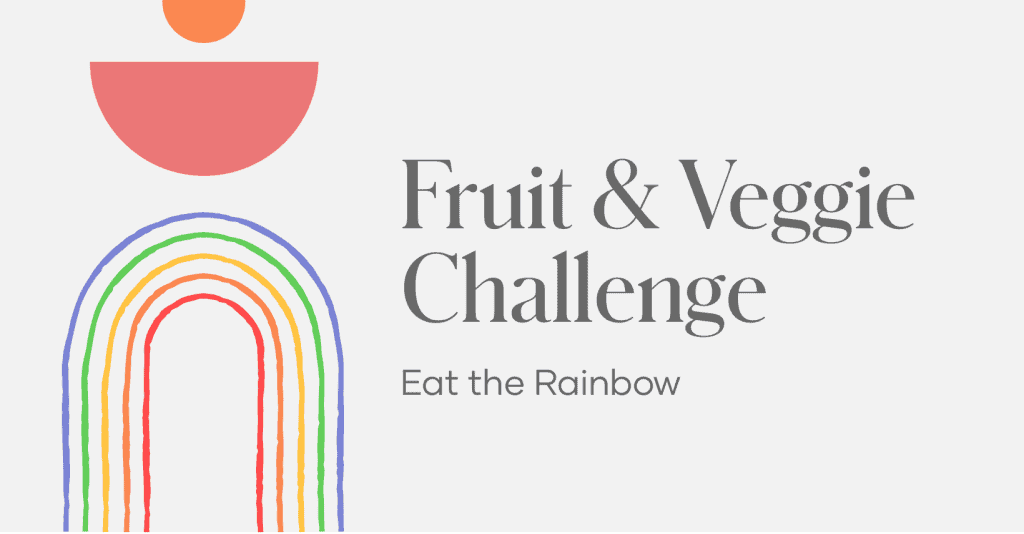
AntiAgingByDesign is proud to offer an Eat The Rainbow Fruit and Veggie Challenge shared by Shaklee who we partner with for our health and wellness choices.
You are welcome to start on the day of your choosing!
All of the information will be posted on this page and there will be 5 days of posts – with the most recent on top.
Affiliate Disclaimer: This site contains affiliate links, which means we receive compensation, at no extra cost to you, if you make a purchase using the links provided. We appreciate your support so much!
This is a Free Wellness Challenge, with the goal to: Eat Every Color of the Rainbow for 5 days. Eat a serving of veggies with every meal and snack.
Of course you are welcome to modify any way you would like because doing anything better with your diet is a step in the right direction and something to build upon.
How can you participate if you want to take on the challenge more seriously?
1. Fill out your daily tracker (posted below) each day
2. Post your tracker in the comments section of our daily check-in post with what fruits and veggies you ate of each color.
3. Feel free to post how you are preparing and/or recipes.
4. Anything else you want to share!
This is a fun challenge to get the whole family involved and create healthy habits.
You might ask: WHY “eat the rainbow”– why focus on a variety of COLORS?
A big reason is something called PHYTOCHEMICALS, which are compounds responsible for a plant’s color, smell, and taste. Some of the most potent benefits come from phytochemicals, especially those responsible for color!
Beyond that, fruits and veggies are packed with vitamins, minerals, and antioxidants that support our immune system, promote digestion, and reduce the risk of health challenges. The more different kinds you eat, the larger the variety of benefits you get!
That’s why we want to show you how easy, fun, and delicious it can be to eat your fruits and veggies.
Can you guess the most commonly consumed veggie in America? Drumroll…. the potato! Yep, it’s time to expand our palette to the full spectrum!
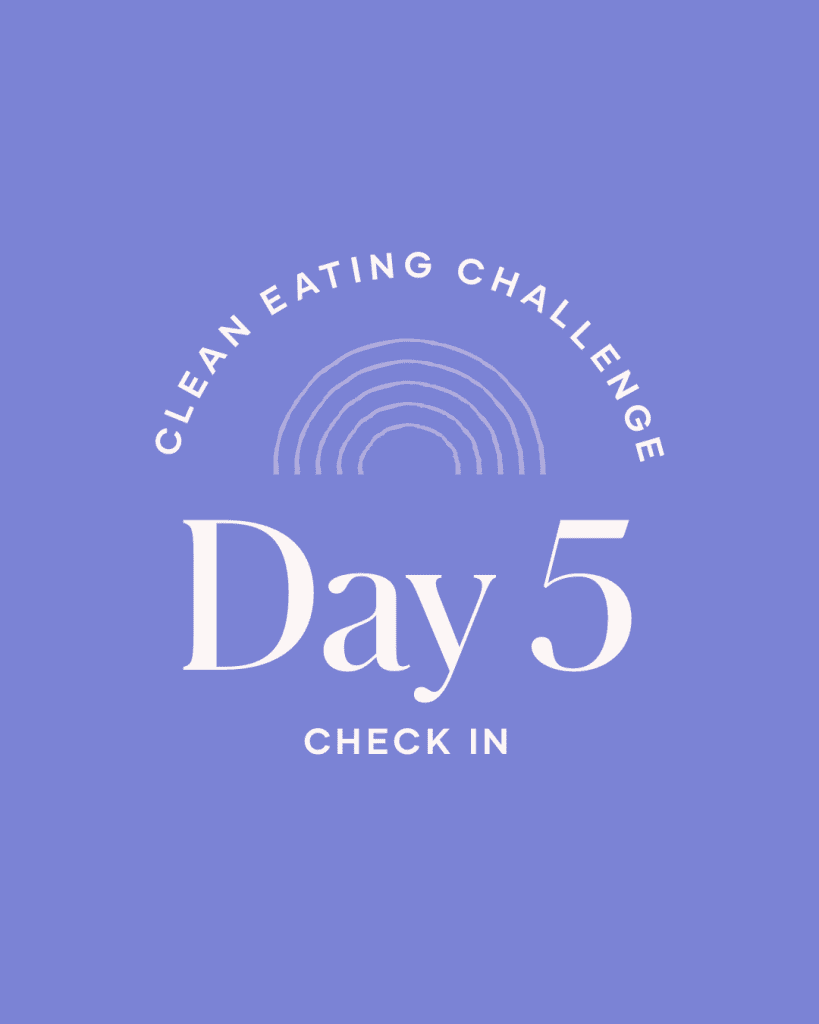
DAY 5
Here we are at Day 5 of Eat the Rainbow Challenge
Ready to finish strong? It’s the last day!
When it comes to fruits and veggies, have you wondered about fresh vs. frozen vs. canned?
Here are some tips to keep in mind:
FRESH Fruits and Vegetables:
- Flavor: Usually provide the best taste, texture, and aroma.
- Nutrient Density: Rich in essential vitamins, minerals, fiber, and antioxidants for your
health and well-being. - Seasonal Availability: May be limited to certain seasons or areas, making them less
accessible or more expensive in off-seasons. - Shelf Life: Require proper storage and timely consumption to avoid spoilage.
FROZEN Fruits and Vegetables:
- Nutrient Content: Typically harvested at peak ripeness and then quickly frozen,
preserving their nutrient content. - Convenience: Easy to store and often pre-cut or pre-portioned, simplifying meal prep.
- Extended Shelf Life: Longer shelf life than fresh foods, preventing waste.
- Texture: Can sometimes be softer or mushier upon thawing. Ideal for produce you will
cook or add to smoothies.
CANNED Fruits and Vegetables:
- Convenience and Shelf Stability: Lonnnnng shelf life, convenient for pantry storage.
- Accessible: Available year-round. Often more budget-friendly than other options.
- Nutrient Loss: May have some nutrient loss, especially of heat-sensitive vitamins like C
and some B vitamins. - Added Salt or Sugars: May contain added sodium or sugar for flavor or preservation.
Compare labels for best options.
PURPLE FOODS
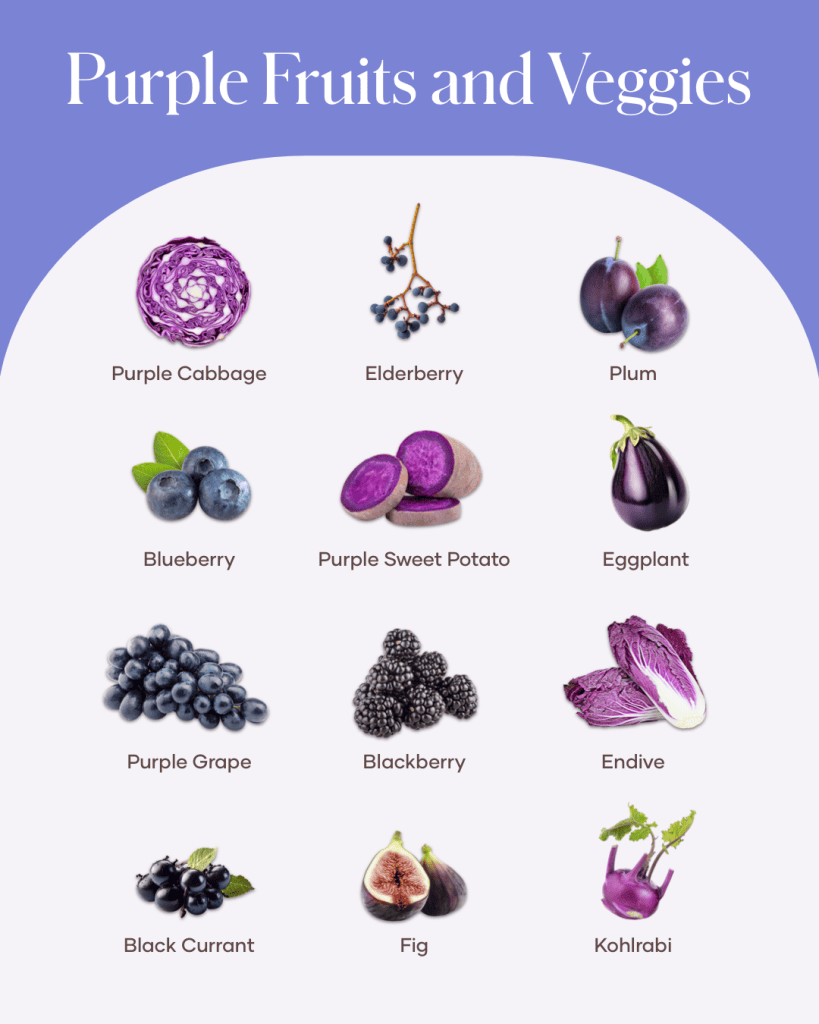
Make some noise for PURPLE! We saved the royal color for last.
What gives purple and indigo-blue foods their color? Potent antioxidants called anthocyanins.
What do PURPLE anthocyanins do for you?
- Help protect your cells from damage caused by harmful free radicals
- May provide anti-inflammatory properties*
- Support your brain health
- Promote a healthy cardiovascular system
- Keep your immune system strong
CHECK OUT the benefits of these purple powerhouses:
Eggplants: Loaded with anthocyanins, fiber, potassium, and folate to help keep your heart and gut healthy.
Blueberries: Regularly indulging in these sweet little berries has been linked to improved memory, enhanced learning capacity, and reduced age-related cognitive issues.
Blackberries: From boosting brain health to strengthening your immune system, blackberries are MVPs in the fruit world. All their anthocyanins, vitamin C, and fiber bring some serious health perks to the table.
Purple Grapes: Resveratrol, a superstar antioxidant found in purple grapes (like Concord grapes), is believed to contribute to the “French Paradox,” where moderate wine consumption is associated with a reduced risk of heart disease despite a diet rich in saturated fats.
Purple Cabbage: Packed with vitamins C and K, it helps your immune system and bones
strong.
What are your favorite purple foods?
*Source: Shiyu Li, Binning Wu, Wenyi Fu, and Lavanya Reddivari. The Anti-inflammatory Effects
of Dietary Anthocyanins against Ulcerative Colitis. Int J Mol Sci. 2019 May; 20(10): 2588.
Scroll down for Days 1 – 4 content.
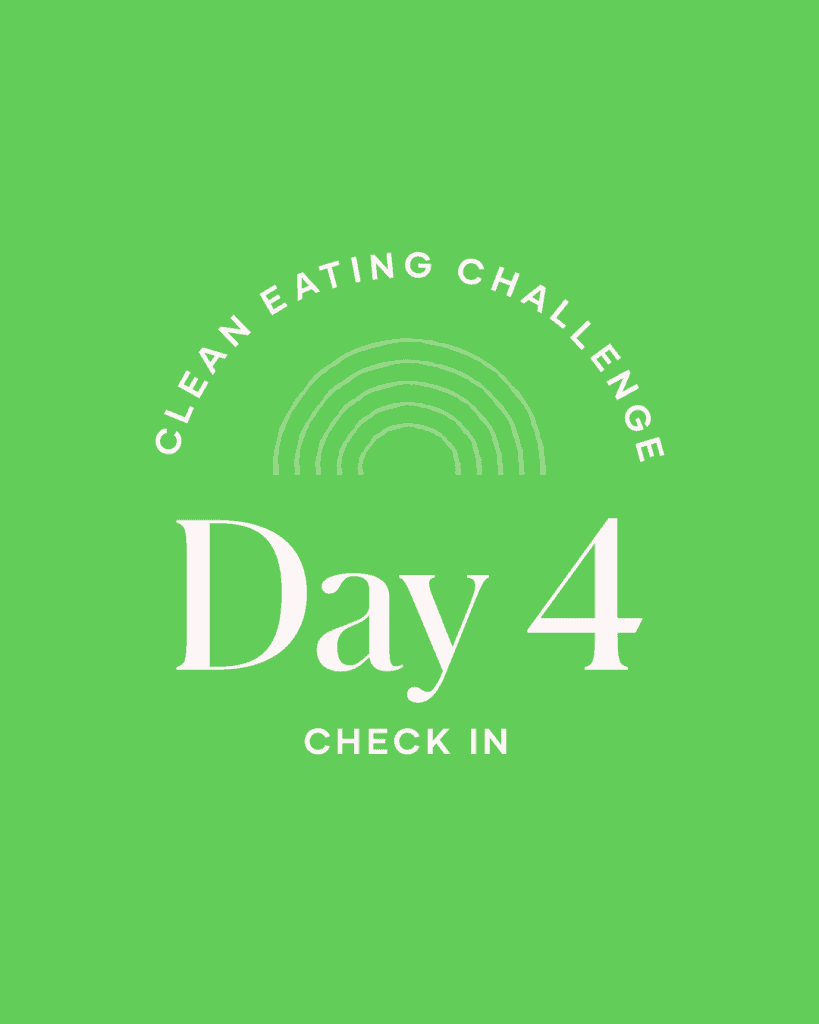
DAY 4
This week is going by so fast! It’s Day 4 and you guessed it:
GREEN FOODS
Who loves green foods? Are asparagus, brussels sprouts and spinach all staples in your diet?
Take a look at the many powers of GREEN fruits and veggies.
The phytonutrient lutein, common in green foods, offers powerful eye-health benefits.
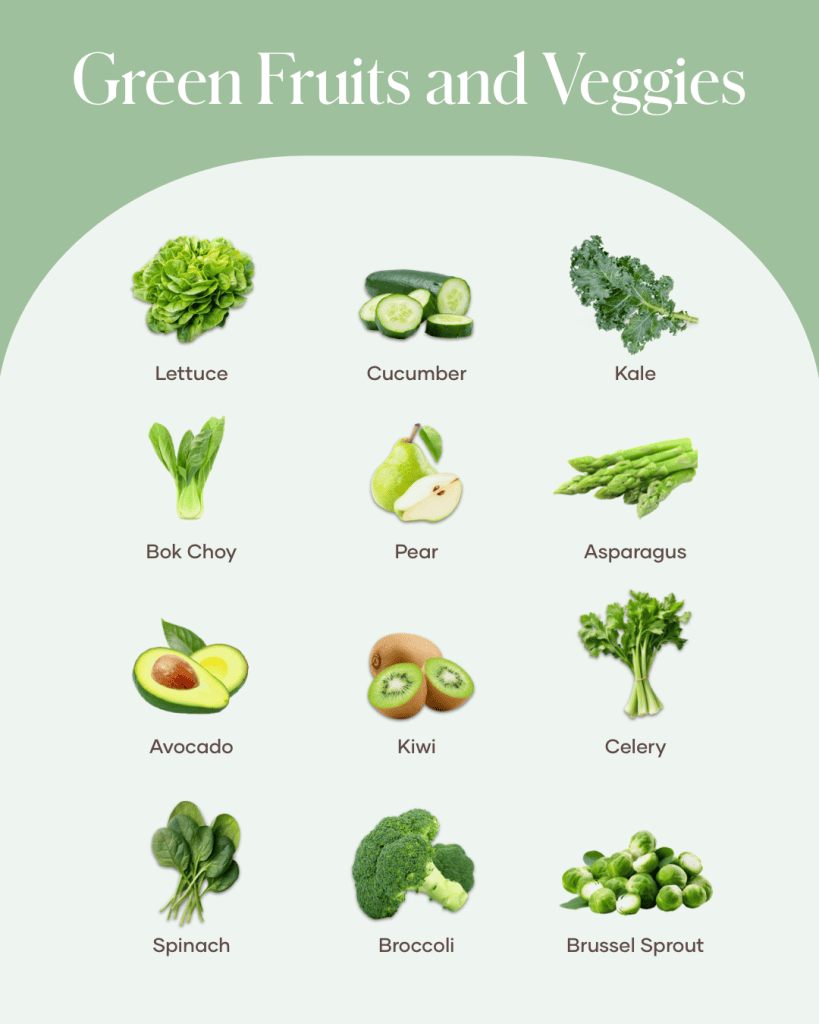
Most green produce contains fabulous folate, which helps your cells work and tissues grow.
But that’s not all. CHECK OUT what these green superheroes can do:
Broccoli and Brussels Sprouts: Help keep your heart healthy and gut happy thanks to all their vitamin C, folate, and fiber.
Cucumbers: Incredibly hydrating, they are about 96% water! Cucumbers are also infused with vitamins K and C and silica, a great combo for beautiful skin and hair.
Leafy Greens (like Spinach and Kale): Packed with vision-protective phytonutrients, plus vitamins A, C, and K, and minerals to help your bones and immune system stay strong.
Avocados: Promote a healthy brain and complexion thanks to all their monounsaturated fats, vitamin E, and folate. A great addition to any meal, they help you absorb fat-soluble vitamins (like A and K) in other foods.
Zucchinis: Rich in vitamin K and potassium to support healthy blood pressure. Also hydrating.
Green Apples: Fiber champions that help satisfy, regulate blood sugar, and boost gut health. (They have even more fiber than red apples!)
Kiwi: Outshining oranges in their vitamin C concentration, these are antioxidant powerhouses that support your immune function and collagen synthesis.
What do you think – has eating more veggies and fruits gotten easier over the week?
The goal is to keep up the good work! Doing the best you can benefits YOU! ?
Creating new habits takes about 60 days to become routine. Keep eating more fruits and veggies daily and it will eventually stick as a habit and your entire body will feel better from the inside out.

DAY 3
Happy Wednesday! It’s Day 3 and halfway through Eat the Rainbow Challenge.
Are you increasing your colorful produce intake?
As you add more fruits and veggies, you might wonder: What does a serving size look like?
We’ve got you. Take a look.
Fruit serving sizes:
One serving of berries (eg, strawberries, blueberries, or raspberries) is about 1 cup, which isroughly the size of your closed fist.
A medium-sized banana counts as one serving of fruit.
An apple or orange is also considered one serving.
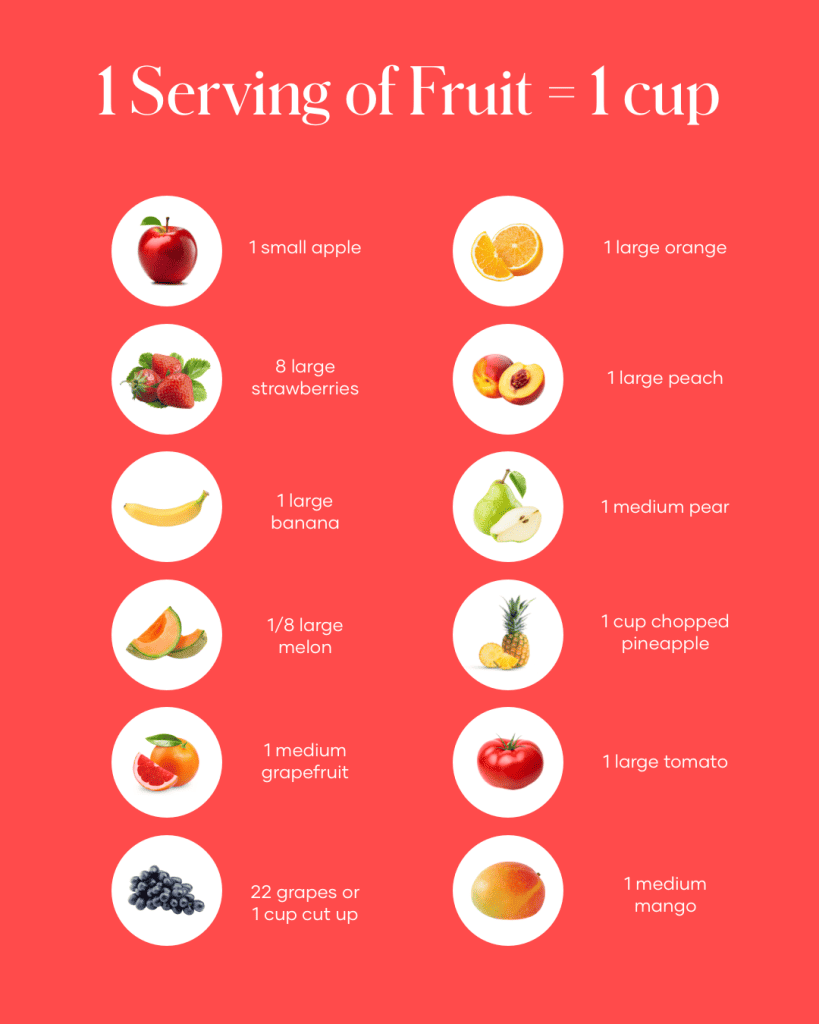
Veggie serving sizes:
One serving of leafy greens (like spinach or kale) is about 2 cups, which is roughly the size of two tennis balls.
One medium-sized carrot or a half-cup of chopped vegetables (such as bell peppers or broccoli) is considered one serving.
A half-cup of corn or peas counts as one serving of veggies
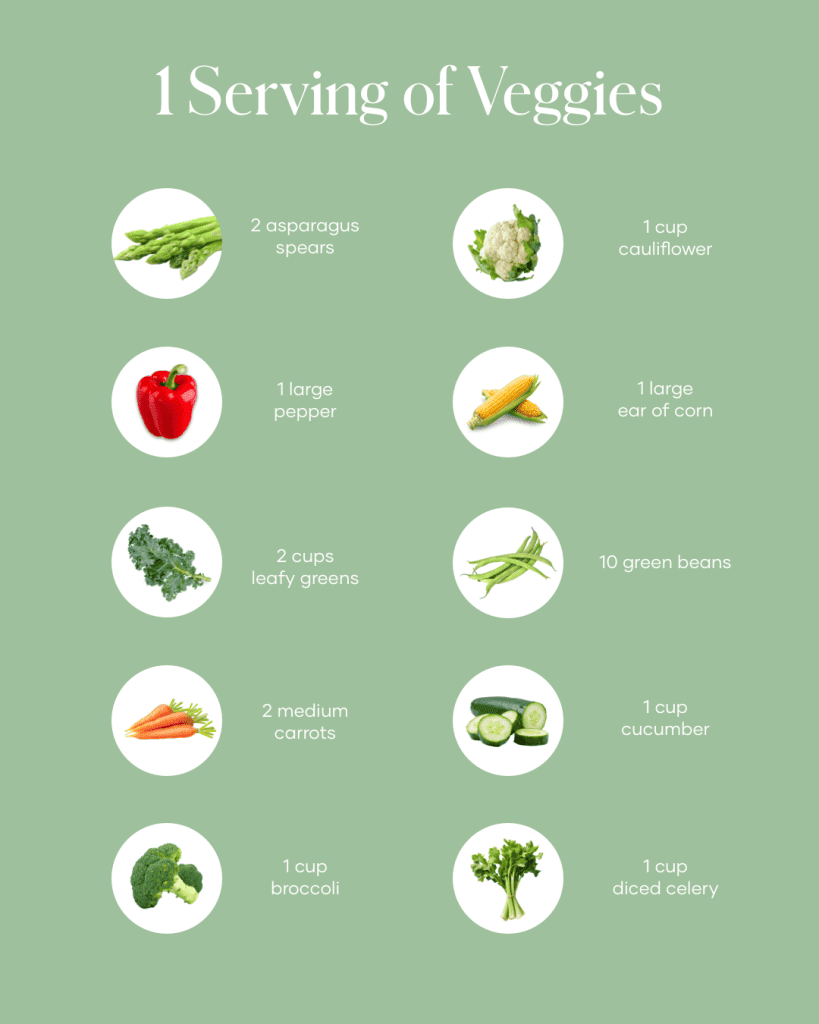
YELLOW FOODS
We are big yellow fans at our house. We love our bananas, corn, and pineapple. What are your favorite yellow foods?
Let’s unpack the magic of YELLOW fruits and veggies?
- They are excellent sources of vitamin C, which means they are great for your immune function and support your skin’s healthy glow.
- They are also bursting with antioxidants, including beta-carotene and flavonoids, which help protect your cells from oxidative damage.
But wait, there’s more! Check out these yellow superstars:
Bananas: Not JUST a tasty snack, they’re packed with potassium for healthy blood pressure and vitamin B6 for brain health.
Lemons: Besides being rich in vitamin C, the citric acid in lemons may improve digestion.
Pineapples: Help you digest proteins, thanks to an enzyme called bromelain.
Yellow bell peppers: Filled with vitamin C and eye-protecting carotenoids like lutein and zeaxanthin, which may help prevent cataracts.?
Corn: Fiber-packed and loaded with antioxidants to protect your cells, like zeaxanthin, lutein, and ferulic acid.
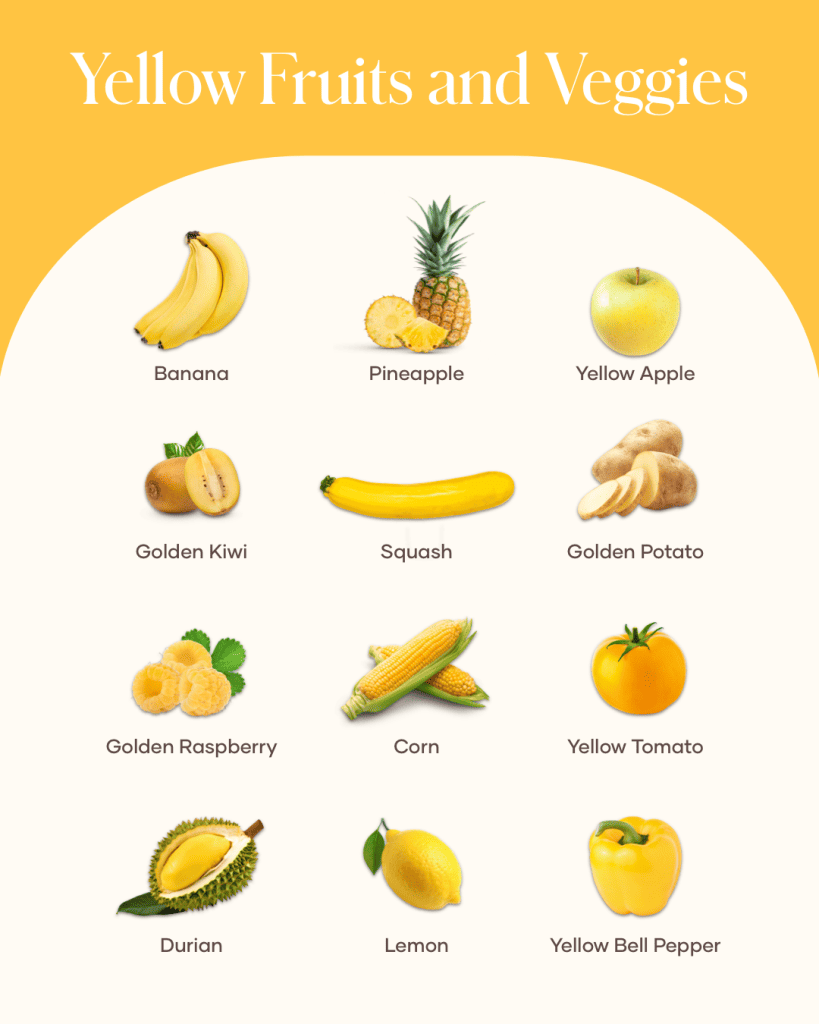
RECIPE
Need a new recipe? Doesn’t this look so good?
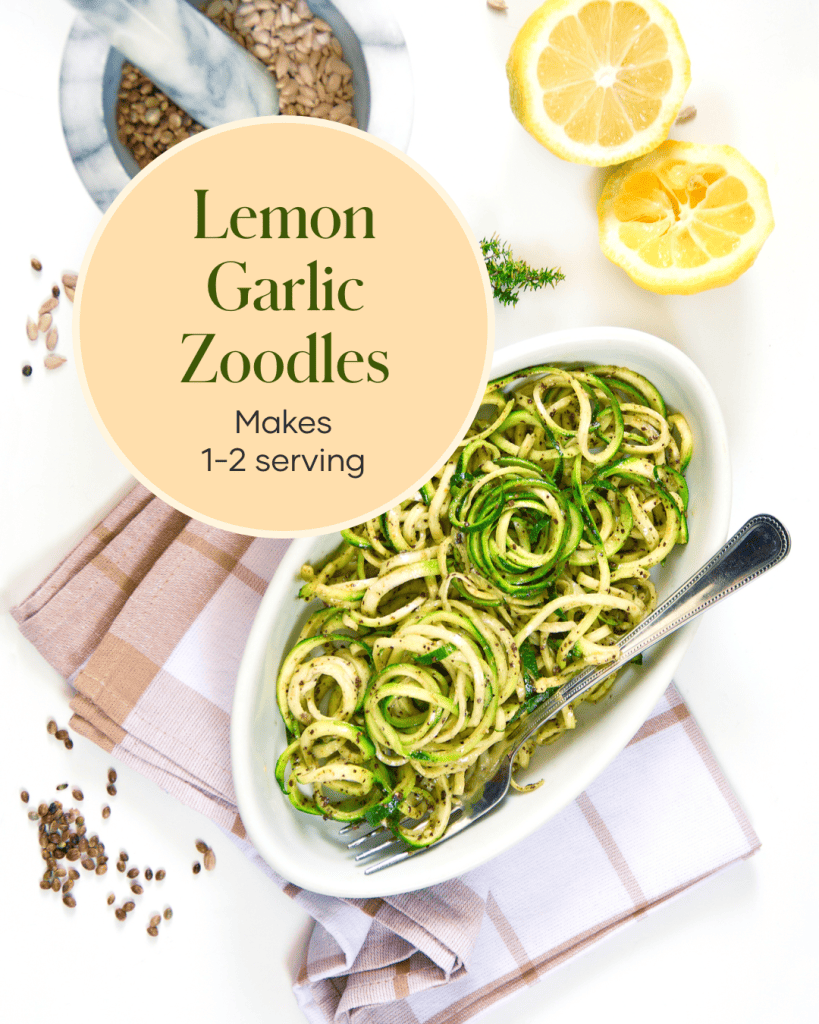


*Source: Christen WG, Liu S, Glynn RJ, Gaziano JM, Buring JE. Dietary carotenoids, vitamins C and E, and risk
of cataract in women: a prospective study. Archives of Ophthalmology. 2008 Jan 1;126(1):102-9.
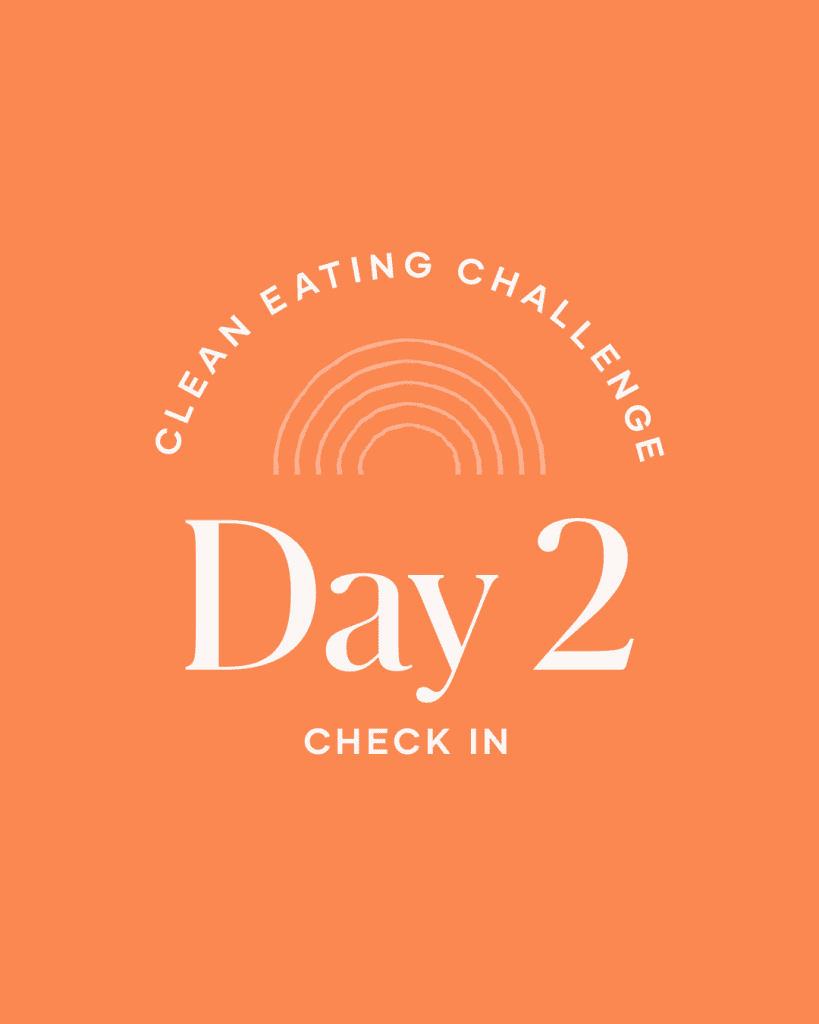
DAY 2
TIPS on how to eat more veggies:
Prepare Veggies in Advance: Wash, cut, and store them in the fridge in easy-to-grab containers.
When you’re hungry or ready to cook, you’ll thank yourself!
Add Flavor: Experimenting with spices, herbs, or sauces can make your veggies super satisfying. Have you ever roasted vegetables with garlic, olive oil, and a dash of salt? How about adding hot sauce to cooked veggies for a spicy kick?
Blend Them into Smoothies: Try mixing spinach, kale, or other leafy greens into a fruit smoothie for a healthy and delicious drink. If you struggle to eat veggies, blending them into a smoothie is a great place to start.
Sneak Them into Your Meals: Try adding veggies to soups, stews, and casseroles. You can also grate or finely chop them and add them to pasta sauces, chili, or meatloaf.
Try New Veggies: Expand your horizons with veggies you’ve never tried. You may be surprised at how much you enjoy a new vegetable when prepared in a way that appeals to your taste buds.
Add Organic Greens Booster: Slip extra greens into your smoothies and recipes.

ORANGE FOODS
Today is all about orange foods! What’s your favorite ORANGE food?
CHECK OUT the fantastic benefits of orange produce. Their orange comes from carotenoids, powerful antioxidant compounds that support eye health.
Orange fruits and veggies, from carrots to apricots, are rich in vitamin C, which boosts your immune system and promotes collagen.
They’re filled with fiber, promoting healthy digestion and aiding in weight management.
MEET some orange power foods:
Orange Carrots: Not just rich in beta-carotene, they also contain lutein and zeaxanthin, known to benefit eye health.
Oranges: Provide massive amounts of flavonoids, which have antioxidant properties that benefit heart health.
Yams/Orange Sweet Potatoes: Their beta-carotene converts to vitamin A in your body. Vitamin A is vital for healthy vision, supporting your immune system, and promoting skin health. They also have a lower glycemic index than white potatoes, making them more blood sugar friendly.
Orange Squashes: Not just for Halloween! Pumpkins also give you fiber, potassium, and vitamin C. Butternut squash is a great source of vitamin E, an antioxidant that helps protect your cells from free radical damage.
Orange Bell Peppers: Get a shout-out for having more vitamin C than green bell peppers.
Orange Habanero Peppers: The compound that gives them their spicy kick, capsaicin, may aid in boosting metabolism.
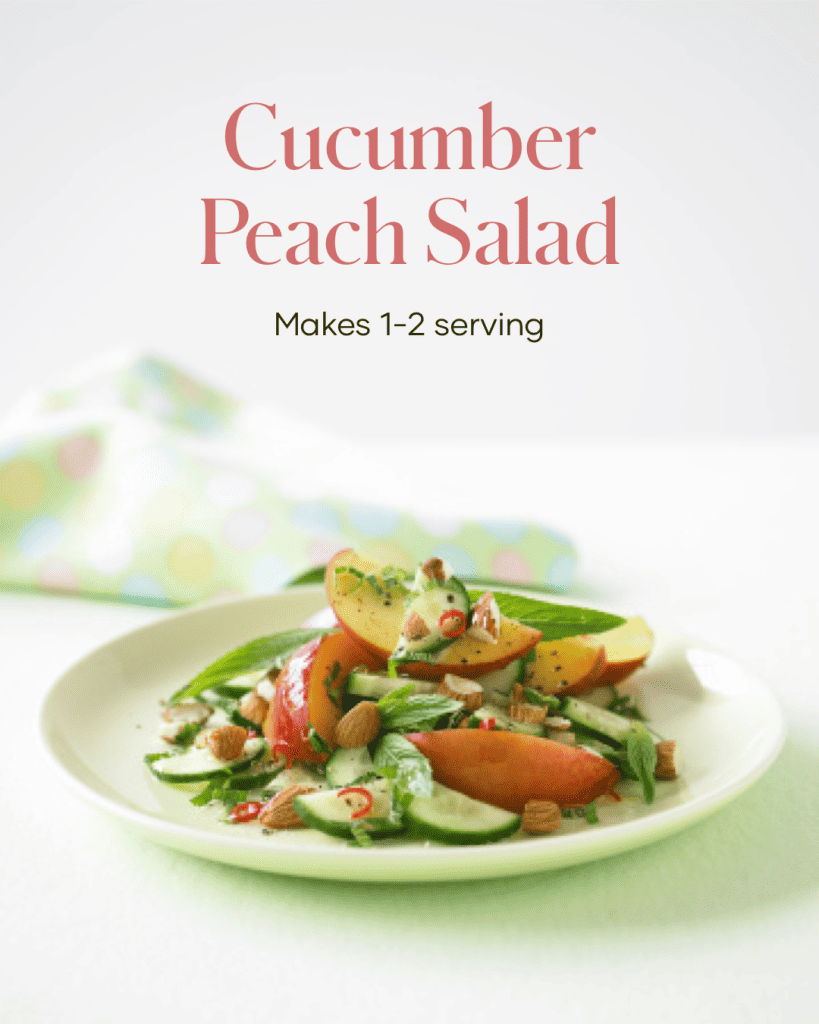
CUCUMBER PEACH SALAD RECIPE
We love this salad because it’s so fresh and has an amazing mix of flavors and textures.
Might we also mention it has SIX different colorful fruits and veggies?
Cucumber Peach Salad
Ingredients:
1 lettuce heart
1 medium sized tomato, diced
1 cucumber, sliced
½ pound ripe peaches, cut into wedges
½ red onion, chopped
1 carrot, peeled and shredded
2 Tbsp lemon Juice
2 Tbsp red wine vinegar
1 ½ tsp olive oil
Small basil leaves for garnish
Directions:
Combine peach, tomato, carrot, lettuce, onion, and cucumber in a large bowl. Mix olive oil, lemon juice, vinegar. Pour over peach, tomato, carrot, onion, and cucumber. Toss well to coat. Garnish with basil.
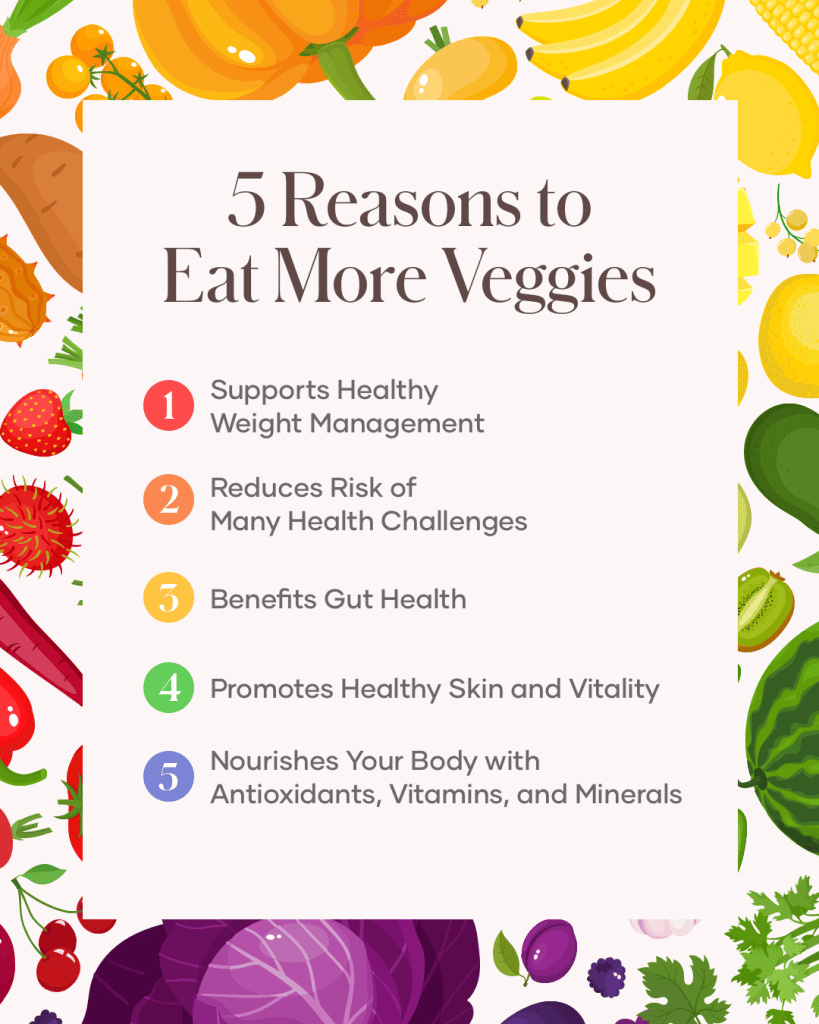
DAY 1
For the next 5 days we are going to “Eat the Rainbow” each day and aim for a serving of veggies with every meal. We will be giving you a tracker to track all of this.
• Discover quick and easy ways to get more fruits and veggies in your diet
• Receive fun recipe ideas
• Learn what certain veggies, fruits, and COLORS can do for you
Print or save the tracker below
Stock up on some colorful fruits and veggies (see ideas in the tracker below)
Your goal will be to eat at least one food from each color group every day, including a serving of veggies with every meal.
Remember it’s perfectly fine if you just want to take in all the info we will be posting and make your own personal challenge to eat more of the rainbow!

If you’re not already motivated, here are 5 GREAT reasons to eat more veggies:
1. Weight Management: Crunchy goodness with slimming benefits! Veggies are nutrient dense and high in water and fiber, a perfect combo to help you feel fuller longer and consume fewer calories. They also help keep you hydrated.
2. Health Protection: Studies have shown that a fruit-and-veggie-rich diet can lower the risk of heart disease, protect against some types of cancer, reduce the risk of eye and digestive problems, AND have a positive effect on blood sugar!
3. Gut Health: A happy gut means stronger immunity, a better mood, and a healthier you. Packed with fiber and water, veggies help keep things moving smoothly, support good gut bacteria, and helps digestive issues.
4. Improved Skin and Vitality: Would you like that healthy glow? The nutrients and antioxidants in veggies support collagen and help contribute to a youthful complexion. They also support the energy you need for a vibrant and active life.
5. Nutrient Powerhouses: Veggies are like little health bombs, providing a wide range of nutrients like vitamin C, vitamin A, potassium, folate, and fiber. Say hello to a well-nourished body.
When it comes to vegetables, the more, the merrier! Your body will thank you for making these earth-grown energy engines a delicious part of your daily meals.
What’s one reason you are trying to eat more fruits and veggies?
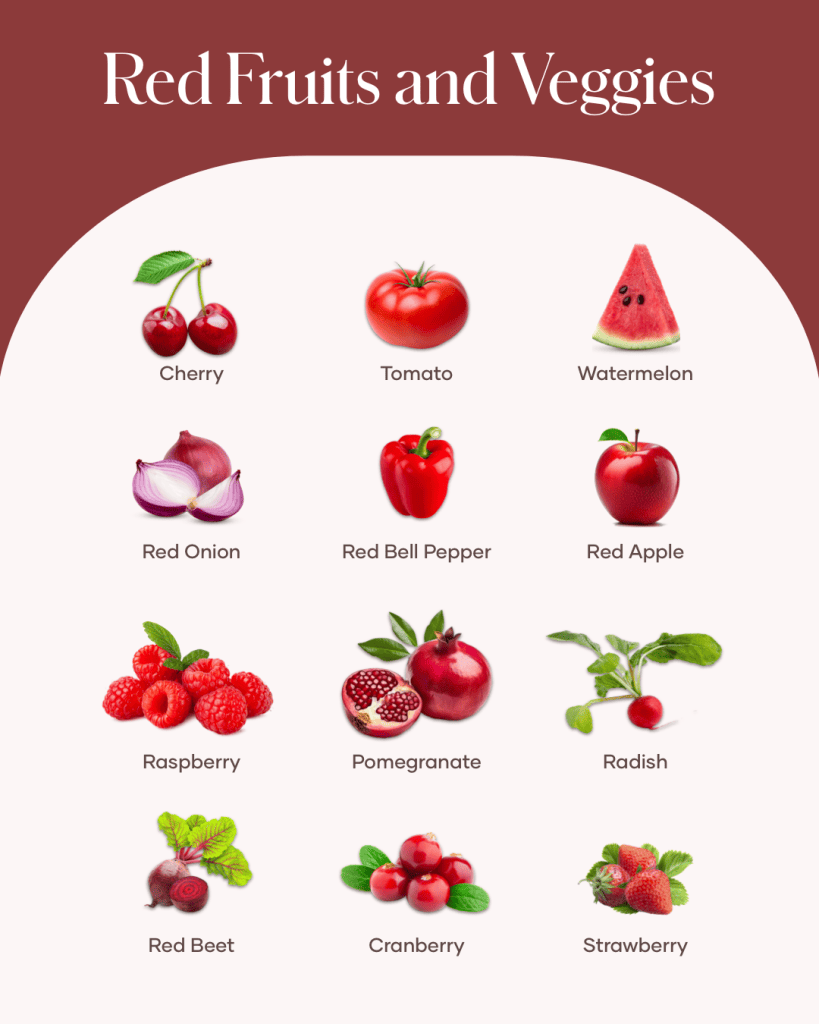
Let’s talk about the power of RED foods! What’s your favorite? I love strawberries!
Check out the amazing BENEFITS we get from red fruits and veggies.
Vitamin C, abundant in red fruits and veggies, boosts our immune system and supports collagen production.
Lycopene and anthocyanins, phytonutrients in red produce, have shown anti-inflammatory properties.
CHECK OUT what these crimson powerhouses can do for you:
Cherries: These sleep-enhancing superstars contain melatonin, a hormone that regulates sleep-wake cycles. Enjoying cherries or tart cherry juice may help you sleep better. They also provide anthocyanins for brain and heart health.
Tomatoes, Watermelon, and Red Peppers: The lycopene in these beauties may and be anti-inflammatory and support heart health.
Bonus: they also provide fiber for good digestion. Red bell peppers deserve special mention for packing more vitamin C than oranges!
Red Beets: Get their vibrant hue from betalain, which offers antioxidant properties and may support liver health and detoxification.
Berries and Pomegranates: Studies suggest that anthocyanins found in these fruits can improve your cognitive function and cardiovascular health.
Cranberries: Research suggests these berries have properties that help prevent urinary tract infections.
Be sure to enjoy berries, tomatoes, red bell peppers, cherries, cranberries, and beets in your diet to harness their incredible benefits.
To learn more about Shaklee, visit our personal website: The Most Clinically Proven Wellness Company.
We are not medical professionals. We are regular people just like you, and we’ve been on a healthy living journey for the past 43 years to live younger, energized and healthy longer.
*These statements have not been evaluated by the Food and Drug Administration. These products are not intended to diagnose, treat, cure, or prevent any disease.
Sources:
He FJ, Nowson CA, Lucas M, MacGregor GA. Increased consumption of fruit and vegetables is related to a reduced
risk of coronary heart disease: meta-analysis of cohort studies. Journal of Human Hypertension. 2007
Sep;21(9):717-28
Farvid MS, Chen WY, Rosner BA, Tamimi RM, Willett WC, Eliassen AH. Fruit and vegetable consumption and breast
cancer incidence: Repeated measures over 30 years of follow-up. International journal of cancer. 2018 Jul 6.
Lembo A, Camilleri M. Chronic constipation. New England Journal of Medicine. 2003 Oct 2;349(14):1360-8.
Christen WG, Liu S, Schaumberg DA, Buring JE. Fruit and vegetable intake and the risk of cataract in women–. The
American journal of clinical nutrition. 2005 Jun 1;81(6):1417-22.
Bazzano LA, Li TY, Joshipura KJ, Hu FB. Intake of fruit, vegetables, and fruit juices and risk of diabetes in
women. Diabetes Care. 2008 Apr 3
Zilong Ma, Bin Du,Jun Li, Yuedong Yang, and Fengmei Zhu. An Insight into Anti-Inflammatory Activities and
Inflammation Related Diseases of Anthocyanins: A Review of Both In Vivo and In Vitro Investigations. Int J Mol
Sci. 2021 Oct; 22(20): 11076.
Jae Hoon Cha,
1 Woo Kyoung Kim,
1 Ae Wha Ha,
1 Myung Hwan Kim. Anti-inflammatory effect of lycopene in SW480
human colorectal cancer cells. Nutr Res Pract. 2017 Apr; 11(2): 90–96.
A myth no more: Cranberry products can prevent urinary tract infecdons for women:
heps://www.sciencedaily.com/releases/2023/04/230420080722.htm
Gabrielle Williams, Deirdre Hahn, Jacqueline H Stephens, Jonathan C Craig, Elisabeth M Hodson. Cranberries for
reducing the risk of urinary tract infec4ons. Cochrane Database of Systematic Reviews, 2023; 2023 (4)
DOI: 10.1002/14651858.CD001321.pub6
